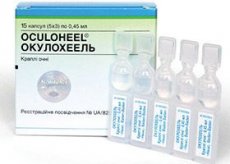Medical expert of the article
New publications
Preparations
Oculocheel
Last reviewed: 03.07.2025

All iLive content is medically reviewed or fact checked to ensure as much factual accuracy as possible.
We have strict sourcing guidelines and only link to reputable media sites, academic research institutions and, whenever possible, medically peer reviewed studies. Note that the numbers in parentheses ([1], [2], etc.) are clickable links to these studies.
If you feel that any of our content is inaccurate, out-of-date, or otherwise questionable, please select it and press Ctrl + Enter.

Oculoheel is a complex type homeopathic medicine.
Indications Oculoheel
It is indicated for irritations, inflammatory processes and allergic manifestations in the eyelids and conjunctiva. These disorders are associated with external stimuli. The drug is usually used to treat dry keratoconjunctivitis and eye strain.
Release form
It is produced as an eye solution (drops), in polyethylene capsules with a volume of 0.45 ml. A separate pack contains 15 capsules with solution.
Pharmacodynamics
The medicine has analgesic, anti-inflammatory and anti-allergic properties. The mechanism of action is carried out by activating the body's immune system, as well as stabilizing the functions that have been disrupted. This occurs due to the plant components included in the composition of the drug.
Dosing and administration
The solution is used for eye drops. Before starting the procedure, be sure to wash your hands. Next, take the capsule with the solution, open it, then press on its side walls and drop it into each eye.
For adolescents aged 12 and over, as well as adults, the medicine is prescribed in the amount of 2 drops of solution in the affected eye three times a day. In case of increased strain on the eyes, it is often necessary to instill 2 drops of solution in each eye three times a day.
For children aged 6-12 years, the dose is often 2 drops of solution, 2-3 times a day, instilled into the affected eye.
Children aged 3-6 years need to put 2 drops of the medicine into the affected eye twice a day.
Children aged 1-3 years need to instill 2 drops of the medicine into the affected eye 1-2 times a day.
For infants under 1 year of age and newborns, the solution is usually instilled once a day - 1-2 drops in the affected eye.
The therapeutic course usually lasts for 1-3 weeks.
 [ 1 ]
[ 1 ]
Use Oculoheel during pregnancy
There is no data on the toxic effect of the drug (its components - homeopathically diluted components) on pregnant and lactating women. Also, no negative reactions were found.
Only the attending physician can prescribe Oculoheel, taking into account the ratio of potential risk and possible benefit from the use of the drug.
Contraindications
Contraindications include: intolerance to one of the active ingredients of the drug or plants from the Asteraceae category.
Side effects Oculoheel
Occasionally, patients may develop manifestations of hypersensitivity (including local allergic symptoms - burning or redness).
Storage conditions
The solution should be kept out of the reach of small children. Temperature values are maximum 25°C.
 [ 2 ]
[ 2 ]
Shelf life
Oculoheel is permitted to be used for a period of 2 years from the date of release of the medicinal solution.
Attention!
To simplify the perception of information, this instruction for use of the drug "Oculocheel" translated and presented in a special form on the basis of the official instructions for medical use of the drug. Before use read the annotation that came directly to medicines.
Description provided for informational purposes and is not a guide to self-healing. The need for this drug, the purpose of the treatment regimen, methods and dose of the drug is determined solely by the attending physician. Self-medication is dangerous for your health.

